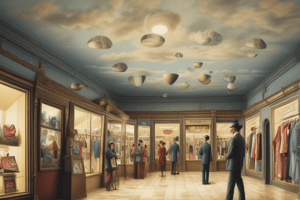Podcast
Questions and Answers
What is the primary goal of visual merchandising in retail?
What is the primary goal of visual merchandising in retail?
- To capture attention and drive sales (correct)
- To reduce brand identity
- To rearrange products within stores
- To decrease customer engagement
Which elements are combined in visual merchandising to enhance customer engagement?
Which elements are combined in visual merchandising to enhance customer engagement?
- Staff training programs
- Product pricing and discounts
- Supply chain management techniques
- Lighting, color palettes, and textures (correct)
How much increase in sales has well-designed store layouts and displays been shown to achieve?
How much increase in sales has well-designed store layouts and displays been shown to achieve?
- Over 50%
- Around 10%
- Up to 5%
- Approximately 20% (correct)
What role does visual merchandising play in a crowded marketplace?
What role does visual merchandising play in a crowded marketplace?
Which of the following is NOT a component typically involved in visual merchandising?
Which of the following is NOT a component typically involved in visual merchandising?
In what way can visual merchandising be likened to in-store personnel?
In what way can visual merchandising be likened to in-store personnel?
What is one of the key benefits of effective visual merchandising according to the text?
What is one of the key benefits of effective visual merchandising according to the text?
How can visual merchandisers draw customers deeper into brand stories?
How can visual merchandisers draw customers deeper into brand stories?
What is a strategy to highlight key products in visual merchandising?
What is a strategy to highlight key products in visual merchandising?
Why is it important for visual merchandisers to balance artistry with logistics?
Why is it important for visual merchandisers to balance artistry with logistics?
Which of the following is a challenge faced by visual merchandising professionals according to the text?
Which of the following is a challenge faced by visual merchandising professionals according to the text?
What drives many successful retail organizations to invest in visual merchandising despite challenges?
What drives many successful retail organizations to invest in visual merchandising despite challenges?
Flashcards are hidden until you start studying
Study Notes
Unlocking Potential through Visual Merchandising in Retail
Visual merchandising is a strategic approach that goes beyond simply arranging products within retail spaces. It's a powerful tool aimed at capturing attention, driving sales, and creating memorable shopping experiences that enhance brand identity. Let's dive into this crucial aspect of retail operations and uncover its importance and techniques.
What is Visual Merchandising?
At its core, visual merchandising involves transforming stores into visually appealing environments by designing displays that highlight product features. This discipline combines elements such as lighting, color palettes, textures, and spatial arrangements with creative strategies and storytelling techniques, all geared towards enhancing customer engagement. Think of it like a silent salesperson who can inspire shoppers without uttering a single word.
Why is Visual Merchandising Important in Retail?
Visual merchandising plays a pivotal role in several aspects of retail success:
- Increasing Sales: Well-designed store layouts and eye-catching displays have been shown to significantly boost sales, often by upwards of 20%. According to one study reported in Forbes, merchants see returns ranging from $18 for every dollar spent on visual merchandising.
- Standing Out Competitively: In today's crowded marketplace, visual merchandising helps differentiate your business, making you more attractive to consumers.
- Encouraging Brand Perception: Effective visual merchandising presents opportunities to reinforce your brand image, values, and personality.
Techniques and Strategies
Visual merchandisers employ various tactics to create compelling retail scenes:
- Storytelling: By developing narratives around products, brands can draw customers deeper into their stories and foster emotional connections, leading to a positive response during purchasing decisions.
- Highlighting Key Products: Draw focus to high margin items, new arrivals, or seasonal collections using prominent placement, bold signage, or unique display methods.
- Maximizing Display Space Efficiency: Break free from traditional categories and explore alternative ways to organize products based on themes, styles, or seasons.
- Creating a Balance between Artistry and Logistics: While artistic expression is essential in visual merchandising, practical considerations must also factor in; essentially, balancing creativity with feasibility and viability.
Challenges Faced by Visual Merchandising Professionals
Despite the numerous benefits associated with visual merchandising, professionals face certain challenges when implementing these practices:
- Time Constraints: Merchandising teams may struggle to keep pace with rapidly changing trends, designs, and inventory while maintaining consistency across multiple locations.
- Resource Limitations: Accessible tools, materials, and training resources may vary depending upon the size and budget of the company.
- Limited Experimentation Opportunities: Some companies might hesitate to take risks due to concerns over potential losses linked to experimentation efforts.
Yet, despite these obstacles, many successful retail organizations continue to invest in visual merchandising because they understand its key role in building brand reputation and driving revenue growth. As technology evolves, innovative solutions and software will likely emerge to help visual merchandisers overcome these challenges and unlock even more exciting possibilities.
Studying That Suits You
Use AI to generate personalized quizzes and flashcards to suit your learning preferences.




